*DH 100: Three prototypes.
*Vampire Mk I: Single-seat fighter version for the RAF, 244 production aircraft being built.
*Vampire Mk II: Three prototypes, with Rolls-Royce Nene turbojet engine. One built and two conversions.
*Vampire F 3: Single-seat fighter for the RAF. Two prototypes were converted from the Mk 1 and 202 production aircraft were built.
*Vampire Mk IV: Nene engined project, not built.
*Vampire FB 5: Single-seat fighter-bomber version. Powered by the Goblin 2 turbojet, 930 being built for the RAF and 88 for export.
*Vampire FB 6 : Single-seat fighter-bomber built in Switzerland for the Swiss Air Force. Powered by a Goblin 3 turbojet, 178 being built.
*Vampire Mk 8: Ghost engined, one conversion from Mk 1.
*Vampire FB 9: Tropicalised fighter-bomber . Powered by Goblin 3 turbojet, 326 being built.
*Vampire Mk 10: Goblin powered two-seater prototype, two built.
*Vampire NF 10: Two-seat night fighter version for the RAF, 95 built including 29 as the NF54.
*Sea Vampire Mk10 : Prototype for deck trials. One conversion.
*Vampire Mk 11 or DH 115 Vampire Trainer: Private venture, two-seat jet trainer prototype.
*Vampire T 11: Two-seat training version for the RAF. Powered by a Goblin 35 turbojet engine, 731 were built.
*Sea Vampire F 20: Naval version of the FB 5, 18 were built.
*Sea Vampire Mk 21: Three aircraft converted for trials.
*Sea Vampire T 22: Two-seat training version for the Royal Navy, 73 were built.
*Vampire FB 25: FB 5 variants, 25 exported to New Zealand
*Vampire F 30: Single-seat fighter-bomber version for the RAAF. Powered by Roll-Royce Nene turbojet, 80 built in Australia.
*Vampire FB 31: Nene engined, 29 built in Australia.
*Vampire F 32: One Australian conversion with air conditioning.
*Vampire T 33: Two-seat training version. Powered by the Goblin turbojet, 36 were built in Australia.
*Vampire T 34: Two-seat training version of the Royal Australian Navy, five were built in Australia.
*Vampire T 34A: Vampire T 34s fitted with ejector seats.
*Vampire T 35: Modified two-seat training version, 68 built in Australia.
*Vampire T 35A: T33 conversions to T35 configuration.
*Vampire FB 50: Exported to Sweden as the J 28B, 310 built, 12 of which were eventually rebuilt to T 55 standard.
*Vampire FB 51: export prototype (one conversion) to France.
*Vampire FB 52: Export version of Mk 6, 101 built.
*Vampire FB 52A: Single-seat fighter-bomber for the Italian Air Force, 80 built in Italy.
*Vampire FB 53: Single-seat fighter-bomber for the Armee de l'Air, 250 built in France, as the Sud-Est SE 535 Mistral.
*Vampire NF 54: Export version of Vampire NF 10 for the Italian Air Force, 29 being built.
*Vampire T 55: Export version of the DH 115 trainer, 216 built and six converted from the T 11.














 Credit: AIRLINERS.NET
Credit: AIRLINERS.NET Would this be the correct version of the De Havilland trainer to get for Swedish Air Force?

Was the only difference between the T.11, T.22, T.33, T.34, T.35 and the T.55 versions that the T.11 was built for RAF, the T.22 for RN, the T.33, 34 and 35 for RAAF and the T.55 for other countries Air Forces that needed a two seat trainer? Was there any external differences between them? Or was it just the electronics that could be different?















































